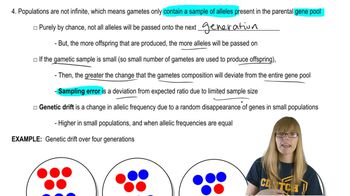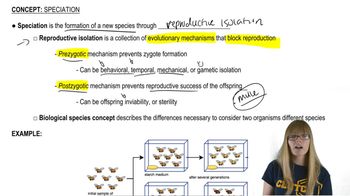A group of finches live on a small, isolate island. One day, a few finches travel to a distant island and start a new population of finches. This type of change in a population is called what?
Table of contents
- 1. Introduction to Genetics51m
- 2. Mendel's Laws of Inheritance3h 37m
- 3. Extensions to Mendelian Inheritance2h 41m
- 4. Genetic Mapping and Linkage2h 28m
- 5. Genetics of Bacteria and Viruses1h 21m
- 6. Chromosomal Variation1h 48m
- 7. DNA and Chromosome Structure56m
- 8. DNA Replication1h 10m
- 9. Mitosis and Meiosis1h 34m
- 10. Transcription1h 0m
- 11. Translation58m
- 12. Gene Regulation in Prokaryotes1h 19m
- 13. Gene Regulation in Eukaryotes44m
- 14. Genetic Control of Development44m
- 15. Genomes and Genomics1h 50m
- 16. Transposable Elements47m
- 17. Mutation, Repair, and Recombination1h 6m
- 18. Molecular Genetic Tools19m
- 19. Cancer Genetics29m
- 20. Quantitative Genetics1h 26m
- 21. Population Genetics50m
- 22. Evolutionary Genetics29m
21. Population Genetics
Allelic Frequency Changes
Problem 1c
Textbook Question
Compare and contrast the terms in each of the following pairs:
Natural selection and Genetic drift
 Verified step by step guidance
Verified step by step guidance1
Define natural selection: Natural selection is the process by which individuals with advantageous traits are more likely to survive and reproduce, passing those traits to the next generation. It is a non-random mechanism driven by environmental pressures.
Define genetic drift: Genetic drift refers to random changes in allele frequencies within a population, often due to chance events like bottlenecks or founder effects. It is a stochastic process and does not depend on the fitness of the alleles.
Compare the mechanisms: Natural selection is a directional process that favors traits increasing an organism's fitness, while genetic drift is random and can lead to the loss or fixation of alleles regardless of their impact on fitness.
Contrast the scale of impact: Natural selection tends to have a stronger effect in large populations where advantageous traits can spread effectively, whereas genetic drift has a more pronounced effect in small populations where random events can significantly alter allele frequencies.
Discuss the outcomes: Natural selection leads to adaptation and increased fitness over time, while genetic drift can result in reduced genetic variation and may even lead to the fixation of deleterious alleles in a population.
 Verified video answer for a similar problem:
Verified video answer for a similar problem:This video solution was recommended by our tutors as helpful for the problem above
Video duration:
2mPlay a video:
Was this helpful?
Key Concepts
Here are the essential concepts you must grasp in order to answer the question correctly.
Natural Selection
Natural selection is a fundamental mechanism of evolution, proposed by Charles Darwin. It occurs when individuals with advantageous traits are more likely to survive and reproduce, passing those traits to the next generation. This process leads to adaptations in populations over time, as beneficial traits become more common while detrimental traits diminish.
Recommended video:
Guided course

Natural Selection
Genetic Drift
Genetic drift is a random process that can lead to changes in allele frequencies within a population, particularly in small populations. Unlike natural selection, which is driven by environmental pressures, genetic drift occurs due to chance events, such as random mating or catastrophic events, resulting in the loss of genetic variation and potentially leading to the fixation of alleles.
Recommended video:
Guided course

Genetic Drift
Comparison of Mechanisms
While both natural selection and genetic drift are mechanisms of evolution, they operate differently. Natural selection is a non-random process that favors traits that enhance survival and reproduction, whereas genetic drift is a random process that can lead to significant changes in a population's genetic makeup without regard to fitness. Understanding these differences is crucial for studying evolutionary dynamics.
Recommended video:
Guided course

Speciation
Related Videos
Related Practice
Multiple Choice
384
views
1
rank


